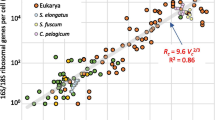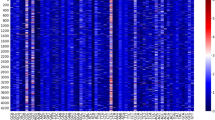Abstract
Ribosomal RNA (rRNA) is one of the most important macromolecules in the cell. It is well established that high-temperature environmental conditions destabilize rRNA, leading to a selection for G+C-rich stabilizing structures. Our knowledge about the nucleotide composition effect of other environmental conditions, however, is limited. In the present work, I addressed this by correlating the rRNA nucleotide composition to known environmental habitats for bacteria. The bacterial phyla Firmicutes, Actinobacteria, and Proteobacteria were chosen for in-depth analyses due to the abundance of information available in the databases. Major differences in nucleotide composition were identified between these phyla. In addition to the G+C→A+T gradients, a main gradient of G+A→C+T was identified for Firmicutes, while a G+T→A+C gradient was identified for Actinobacteria. With respect to correlation to environmental conditions, the Firmicutes showed a main structure of high G+C being correlated to thermophilic conditions, high A+T to anaerobic conditions, and high C+T to halophilic conditions. The main patterns detected for Firmicutes can be explained by structural stability for high G+C, chemical instability of G under aerobic conditions, and structural stability by purine/pyrimidine skew for halophilic conditions. On the contrary, the correlations for Actinobacteria cannot easily be explained by chemical and/or structural stability. This may indicate interference with factors not included in my work. Finally, I found a main correlation between high A+T and endosymbiosis for Proteobacteria. High A+T probably reflects adaptation to cell internal growth. Further support for environmentally driven nucleotide composition shaping was found and that polyphyletic bacteria were associated with the same environment/nucleotide correlations. My conclusion is that environmental conditions and habitats have a major effect on rRNA nucleotide composition but that the effects may differ between the bacterial phyla.






Similar content being viewed by others
References
Aas PA, Otterlei M, Falnes PO, Vagbo CB, Skorpen F, Akbari M, Sundheim O, Bjoras M, Slupphaug G, Seeberg E, Krokan HE (2003) Human and bacterial oxidative demethylases repair alkylation damage in both RNA and DNA. Nature 421:859–863
Blume S, Lebowitz J, Zacharias W, Guarcello V, Mayfield C, Ebbinghaus S, Bates P, Jones D Jr, Trent J, Vigneswaran N, Miller D (1999) The integral divalent cation within the intermolecular purine*purine. pyrimidine structure: a variable determinant of the potential for and characteristics of the triple helical association. Nucleic Acids Res 27:695–702
Cole JR, Chai B, Farris RJ, Wang Q, Kulam SA, McGarrell DM, Garrity GM, Tiedje JM (2005) The Ribosomal Database Project (RDP-II): sequences and tools for high-throughput rRNA analysis. Nucleic Acids Res 33:D294–D296
Conaway CC, Nie G, Hussain NS, Fiala ES (1991) Comparison of oxidative damage to rat Liver DNA and RNA by primary nitroalkanes, secondary nitroalkanes, cyclopentanone oxime, and related compounds. Cacer Res 51:3143–3147
Honda K, Smith MA, Zhu X, Baus D, Merrick WC, Tartakoff AM, Hattier T, Harris PL, Siedlak SL, Fujioka H, Liu Q, Moreira PI, Miller FP, Nunomura A, Shimohama S, Perry G (2005) Ribosomal RNA in Alzheimer disease is oxidized by bound redox-active iron. J Biol Chem 280:20978–20986
Martens H, Næs T (1989) Multivariate callibration. Wiley, Chichester
McEwan CE, Gatherer D, McEwan NR (1998) Nitrogen-fixing aerobic bacteria have higher genomic GC content than non-fixing species within the same genus. Hereditas 128:173–178
Min XJ, Hickey DA (2007) DNA asymmetric strand bias affects the amino Acid composition of mitochondrial proteins. DNA Res 14:201–206
Rocha EP (2004) The replication-related organization of bacterial genomes. Microbiology 150:1609–1627
Rudi K, Zimonja M, Næs T (2006) Alignment independent bi-linear multivariate modeling (AIBIMM) for global analyses of 16S rRNA phylogeny. Int J Syst Evol Microbiol 56:1565–1575
SantaLucia J Jr, Hicks D (2004) The thermodynamics of DNA structural motifs. Annu Rev Biophys Biomol Struct 33:415–440
Thorp HH (2000) The importance of being r: greater oxidative stability of RNA compared with DNA. Chem Biol 7:R33–R36
Usher DA, McHale AH (1976) Hydrolytic stability of helical RNA: a selective advantage for the natural 3′,5′-bond. Proc Natl Acad Sci U S A 73:1149–1153
Wang HC, Xia X, Hickey D (2006) Thermal adaptation of the small subunit ribosomal RNA gene: a comparative study. J Mol Evol 63:120–126
Acknowledgments
This work was supported by Hedmark Sparebank and a research levy on certain agriculture products in Norway. A great thank is also given to Monika Zimonja for revising the statistical treatments.
Author information
Authors and Affiliations
Corresponding author
Electronic supplementary material
Below is the link to the electronic supplementary material.
ESM 1
(PDF 10.4 KB).
Figure S1
Principal component analyses for mononucleotide frequency data for SSU (black circles) and LSU (red squares). The generation of normalized frequency data and the PCA were conducted using the Phylomode program, and plotted using MINITAB. The nucleotide gradients are marked (PDF 35.9 KB).
Table S1
ANOVA of dinucleotide composition in LSU and SSU for global data. 1 p values significant A+T the 5% level are marked (PDF 16.4 KB).
Table S2
Pearson’s correlation analysis for pair-wise comparisons of LSU and SSU PCs1. 1Pairs with significant correlation (p < 0.05) are highlighted. 2The Pearson correlation coefficient and the corresponding p value are shown (PDF 40.7 KB).
Table S3
ANOVA of dinucleotide thermodynamic properties in LSU and SSU for global data. 1The thermodynamic parameters used have previously been described by Santalucia and Hicks6. 2 p values significant A+T, the 5% level are marked (PDF 25.5 KB).
Table S4
ANOVA for bacterial SSU dinucleotide composition. 1 p values significant A+T, the 5% level are marked (PDF 31.7 KB).
Table S5
ANOVA of genome, SSU and LSU dinucleotide composition. 1p-values significant A+T, the 5% level are marked (PDF 26.8 KB).
Rights and permissions
About this article
Cite this article
Rudi, K. Environmental Shaping of Ribosomal RNA Nucleotide Composition. Microb Ecol 57, 469–477 (2009). https://doi.org/10.1007/s00248-008-9446-z
Received:
Accepted:
Published:
Issue Date:
DOI: https://doi.org/10.1007/s00248-008-9446-z




